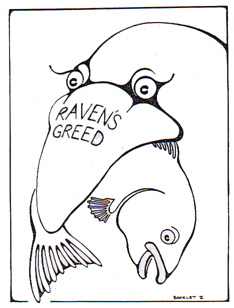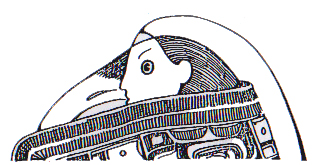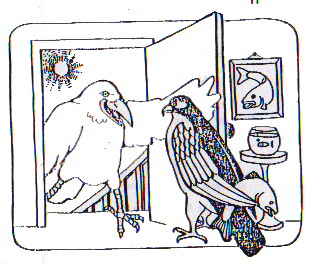 Tlingit Indians of Southeastern Alaska Tlingit Indians of Southeastern Alaska

Click on image for a bigger view
RAVEN STORIES:
V. RAVEN'S GREED: TWO STORIES
Raven Turns Himself into a Woman
Raven and the Fish Hawk
Alaska Multimedia Education Program
Alaska State Museum
Juneau, Alaska 99801
RAVEN TURNS HIMSELF INTO A WOMAN
Introduction
Raven has lost his wife, the Fog Woman.
He wants to get married again, so that people will look after him, and he won't
have to work hard for his food. This time he decides to turn himself into a
woman and become a wife.
Raven is lazy and a bad wife: She steals from the Killerwhale people in the
village where she lives. Then she decides to kill her husband and all the Killerwhales
in the village.
After you read this story, go on to the story of Raven and the Fish hawk which
is a continuation of the same theme.

RAVEN TURNS HIMSELF INTO A WOMAN
Now Raven started on from this place crying, "My
wife, my wife!"
Coming to some trees, he saw a lot of gum on one of them and said to the
tree, "Why, you are just like me. You are in the same state." For he
thought that the tree was crying, just as Raven was crying for his lost wife
the Fog
Woman.
Raven went to another place and turned himself into a woman. Then she (for Raven
was a woman now) thought to herself,
"I must get married and have someone to look after me. But to get a husband,
I must say my father was a great chief. Whose daughter shall I say I am?"
She looked around thoughtfully, and her eyes rested on a sea-gull sitting on
a high rock. In those days, a chief would always pick out a high place in the
village, and would sit there in the morning. The sea-gull sitting on the high
rock reminded her of a chief, so she decided, "I will call the sea-gull
my father. From now on I will call myself Sitter-on-the-High-Cliff's daughter!"
Some time later, a canoe came along filled with men of the Killerwhale clan
who were returning to their village. Raven waved to them, talked to them, and
finally convinced one of them to marry her.
The canoe continued on its journey, with Raven a long this time. When it approached
the village, a man on the beach saw it coming and shouted out, "Where
is your canoe coming from?"
One of the Killerwhales in the canoe replied, "We have been after a wife,
and we have her!"
"Which chief's daughter is she?" people asked when the Killerwhales
arrived in the village. They knew that Raven must be a chief's daughter, for
in those days people never went to fetch a woman by canoe unless she were the
daughter of a chief.
"It is Sitter-on-the-High-Cliff's daughter," the Killerwhales replied.
And all the villagers believed this.
Raven made herself at home in the Killerwhales' house. Soon, the Killerwhales
began to notice that their food was disappearing very rapidly, even though they
were always out fishing and hunting, and had their house piled full with boxes
of grease.
They wondered to each other, "What is wrong? What has become of all the
grease and fat in these boxes?" They could not find out for a long time.
Raven wore a labret in her lip in those days. It was set with abalone shell
and was very valuable. One day, the Killerwhales found this labret in one of
the boxes of grease and said, "Just look at this labret here in this box.
We know who it belongs to!" And they went to Raven and asked her how the labret
got into the box.
Raven exclaimed, "Oh, my labret! That's always the way with my labret.
Whenever it feels like doing so, it will leave my lip and go off anywhere it
chooses!"
For the moment, the Killerwhale people believed Raven.
By and by, Raven said to the Killerwhales, "I wonder what is wrong that
I have such bad dreams. I dreamed that all the people in this village were
asleep,
and my husband went to sleep too and never woke up. My dreams always come
true. Whatever I dream will surely happen."
The people looked at each other with frightened eyes.
Late the next night, Raven got a stick, sharpened the ends, crept to where her
husband slept, and killed him!
Early the next morning, the village people woke and heard her crying, "Oh,
my husband! My husband!" Raven told the people that her husband's last words
had been, "When I'm dead take my body to a place some distance from the
town". The Killerwhale people did this.
Then Raven said, "When you hear me crying, I don't want any of you to
pass the place where I am mourning for him. Leave me alone to cry in peace.
Now,
tie up the fingers of my right hand, so that may eat with my left hand only.
You people must wait on me. You must bring me everything I eat. Also paint
my
face black."
As she was a widow, they had to do everything just as she told them. These are
the rules that people have observed from that time.
Raven stayed there pretending to be mourning for a long time. She was fed by
the Killerwhales and had a very easy life for a time. And whenever anyone heard
her crying near the spot where her husband's body had been laid no one dared
to go near. She lived there a long time, crying. But really she was crying for
joy, because she intended to kill all the Killerwhales...
But that is another story...
RAVEN TURNS HIMSELF INTO A WOMAN
Discussion
These are questions for you to discuss with your friends or your teacher. Or,
you could write out your answers if you wish.
- What does this story tell you about Raven's character?
- What does the story tell you about some Tlingit customs of the past?
- What sort of wife is Raven? Is she different from the Fog Woman in the
way she behaves?
- Discuss the ending of the story. Why do you think Raven killed her husband?
Writing
- Image you could change into something else -- like a raven. Describe what
you would like to be and write about an adventure you might have.
- The story begins with these words:
"How Raven started on from this place crying, 'My wife, my wife.'" Imagine
that you are Raven and write a description of all the sad thoughts that go
through your mind after your wife has left you. You could use these first
words of the story to start with, if you wish.
- Write your own story about Raven. Draw lots of pictures to go with it.
- Raven loved eating. What are your favorite foods? Write a list of
all the things you like to eat most. Then try to describe their tastes. You
could even write a poem about the food you love most. Or write a story about
somebody who simply can't stop eating -- like Raven. Then draw pictures of
the food you've written about. Use color!
Drawing
- Draw a picture of Raven when she was a woman. (It might look funny!)
- Draw a picture of Raven stealing grease from the boxes.

RAVEN AND THE FISH HAWK
After that Raven began to travel. One day he came upon a Fish
Hawk. "Oh, my friend!" cried Raven, as if the hawk were his dearest friend.
Raven entered Fish Hawk's house, looked around and saw a great amount of food.
He smiled broadly when he saw the food.
Raven said to the Fish hawk, "I will stay with you all winter!
We will be partners and share our work and our food!" Fish Hawk agreed.
Raven stayed and stayed; but after a while. Fish hawk became very tired of his
visitor. Raven shared the food all right, but he did not share in the work!
When Raven noticed that Fish hawk was becoming weary of him, he said, "The
time for me to work hasn't come yet. When it's my turn to work, you'll have
plenty of rest. You won't have to do a thing! This beach will be covered with
all kinds of fish. There will be so much fish, you'll get tired of eating it!"
Fish hawk beleived what Raven said. He started thinking about all the things
Raven would do for him, and he forgot about how lazy Raven had shown himself
to be. He let Raven stay at his house.

Meanwhile, as he was waiting for Raven to be ready to start working, Fish hawk
was working all time harder to supply his guest with food. Once in a while he
would get angry at Raven all over again for not sharing in the work.
Then Raven would say, "I remember when we first met, Fish Hawk.
I was very impressed by you, for I knew then that you were a very wealthy person
-- and now I see that I was correct! You are very wealthy and deserve
all my respect!" Fish Hawk was pleased. He forgot about his anger. Clever Raven
knew how to use flattery!
Still, Raven stayed on and on. And he ate more and more.
But he never kept his promise; he never did any work. He never brought home
food.
Then one day the little hawk decided he had had enough. He refused to feed Raven
any more. He left his house and he left Raven to find his own food!
RAVEN AND THE FISH HAWK
The man who told the story you've just read said this about it:
"This is the way it is nowadays with persons who have no respect for themselves.
They go from house to house to be fed by others. Such persons are greedy, great
eaters and lazy.
"People tell their children that those who lead this kind of life are not
respected. A person who tells the truth is always known because he keeps his
word. There was a boy I knew who wouldn't do anything. They used to say to him,
"'You're so lazy that you will he left in some village alone!'
"That is why the Tlingit tried hard to earn their living and make things
comfortable for themselves."
RAVEN AND THE FISH HAWK
Discussion
- What sort of person was the Fish Hawk?
- What did Raven do to make Fish Hawk tired of him?
- The story doesn't say where the Fish Hawk lived. Where do you think he
might live?
- Why do you think Fish Hawk believed Raven when he was only flattering?
Writing
- Have you ever been away on a visit to somebody else's house? If you have,
write a description of your visit.
- Make up a story about a child who goes a long way from home, and stays
with people in a strange place. Imagine you are that child if you like, and
write the story from your point of view.
- Withmout looking at the story again, write the story of Raven and the Fish
Hawk in your own words.
- The Fish Hawk was very kind to Raven. Have you got a friend who is kind
to you? Describe your friend and draw a picture of him or her.
Acting
- 1. Act out the story of Raven and the Fish Hawk. It will only need two people
to act out!
- Imagine somebody comes and stays at your house, and starts eating all your
food, and just lays around being lazy. He is a nice person, but you do wish
that he'd help around the house. Act out a play about what happens.
"RAVEN TURNS HIMSELF INTO A WOMAN" was adapted from John
R. Swanton's Tlingit Myths and Texts (1909) page 114-116.
"RAVEN AND THE FISH HAWK" was adapted from John R. Swanton's
Tlingit Myths and Texts (1909) page 116-117.
Illustrated by Nancy Logue.
TABLE OF CONTENTS
MATERIALS LIST & GOALS
SECTION 1: Tlingit
Country
SECTION 2:
Clans
SECTION 3: Summer
Camp
SECTION 4: Tlingit
Economy: Surplus
SECTION 5: Wrap
Up
APPENDIX A: Brief
Description of Tlingit Culture
APPENDIX B: A Sample
Winter Clan House
APPENDIX C: Northwest
Coast Materials in ASD AVS Center
APPENDIX D: Juvenile
Literature on Northwest Coast Cultures
APPENDIX E: Art
Bibliography
APPENDIX F: Northwest
Coast Cultures Bibliography
APPENDIX G: Schools
Which Own Northwest Coast Study Prints
APPENDIX H: Raven
Stories (reprints)
APPENDIX I: Recorded
Versions of Clan Crest Stories
APPENDIX J: Some
Northwest Coast Art Activities
|